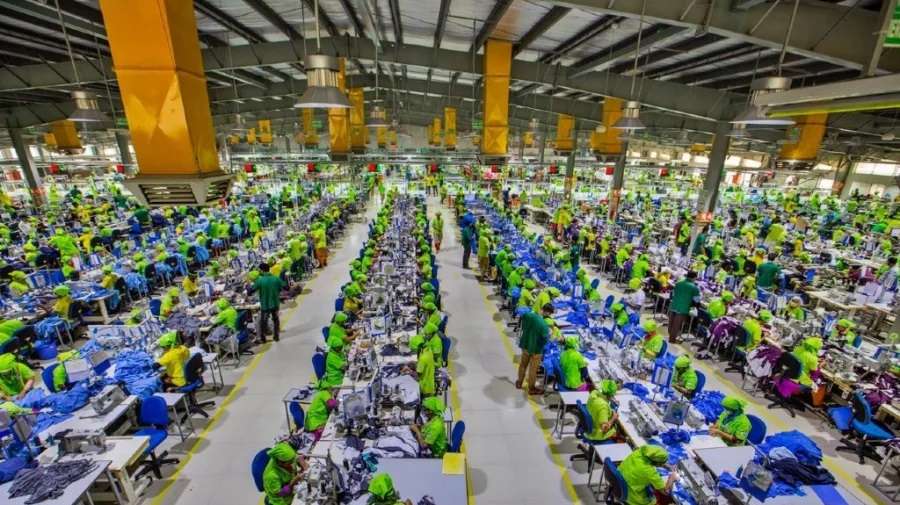"Indonesia is ranked among the top ten largest textile producing countries. However, the nation is far away from threatening China's dominant position. Whereas China controls about 35 per cent of global textile markets, Indonesia controls only about 2 per cent. The Indonesian government targets to increase the nation’s value of exported textiles and garments to $75 billion by the year 2030, implying that this industry would contribute around 5 per cent to global exports. The recent TheInsiderStories data points out that Indonesia has cheaper labour than other textile producing countries."
 Indonesia is ranked among the top ten largest textile producing countries. However, the nation is far away from threatening China's dominant position. Whereas China controls about 35 per cent of global textile markets, Indonesia controls only about 2 per cent. The Indonesian government targets to increase the nation’s value of exported textiles and garments to $75 billion by the year 2030, implying that this industry would contribute around 5 per cent to global exports. The recent TheInsiderStories data points out that Indonesia has cheaper labour than other textile producing countries. For example, Vietnam as one of its main competitors in ASEAN has the minimum wage at the average of $122-176, as compared to Indonesia at the range of $109-274. Notably so Indonesia’s textiles industry in the past had contributed significantly to Indonesia’s economy, representing 10.1 per cent of the total export.
Indonesia is ranked among the top ten largest textile producing countries. However, the nation is far away from threatening China's dominant position. Whereas China controls about 35 per cent of global textile markets, Indonesia controls only about 2 per cent. The Indonesian government targets to increase the nation’s value of exported textiles and garments to $75 billion by the year 2030, implying that this industry would contribute around 5 per cent to global exports. The recent TheInsiderStories data points out that Indonesia has cheaper labour than other textile producing countries. For example, Vietnam as one of its main competitors in ASEAN has the minimum wage at the average of $122-176, as compared to Indonesia at the range of $109-274. Notably so Indonesia’s textiles industry in the past had contributed significantly to Indonesia’s economy, representing 10.1 per cent of the total export.
Back in 2005, the textile industry, which employs around 1.2 million people in 4,500 factories, became the biggest net exporter with a surplus of around $7 billion. Previously in 2004, Indonesia was the biggest textile and clothing exporters in Southeast Asia. Globally, the country reached the ninth rank among the world’s leading clothing exporters and tenth among textiles exporters. But the recent reports trigger a bit of complexity and the challenging scenario for the Indonesian textile industry as the industry has remained uncompetitive due to its high dependency on imported raw materials, high costs of energy and logistics, and market access. As a matter of fact, during the last five years, the Indonesian textile industry has been declining, despite its increasing demand at the global market. During the textile bullish market in 2016, Indonesia’s textile market share only reached 1.8 per cent of the world textile market, which has slipped to 1.6 per cent today.
The country has lost this opportunity to Bangladesh and Vietnam, as its market share is far below Vietnam at 5 per cent and Bangladesh at 7 per cent. Last year, Indonesia only managed to realise total textiles exports at $12.53 billion, far lower than Vietnam which managed to reach at the total $30 billion. Such figures reflect that cheap labour alone can’t do wonders to attract investments, the country needs to brace up on aspects too to win over global trust.
year, Indonesia only managed to realise total textiles exports at $12.53 billion, far lower than Vietnam which managed to reach at the total $30 billion. Such figures reflect that cheap labour alone can’t do wonders to attract investments, the country needs to brace up on aspects too to win over global trust.
Factors restricting growth
The country needs to work on four factors, which include energy cost. Electricity tariff in Indonesia is more expensive than Vietnam and Bangladesh. Indonesia’s electricity tariff is about $0.12 per kWh, much higher than Vietnam and Bangladesh which is only $0.7 and $0.5, respectively. Secondly, Indonesia is still dependent on imports of textile raw materials, so it cannot get cheap raw materials. The high dependence on imports has also made Indonesian textile industry highly susceptible to the changes in the global economy. Indonesia currently imported almost 100 per cent of cotton as Indonesia’s cotton production is only 4 per cent of the total demand. Indonesia imports more cotton from America, Brazil, and Australia.
The textile industry in Indonesia is also hampered by high logistics cost, which is the highest in Southeast Asia. Logistics cost including transport, warehousing, and inventory in Indonesia has so far accounted for 24 per cent of the country’s GDP. The country’s logistics cost-to-GDP ratio is far higher than those of neighbouring countries, including Thailand and Malaysia where the ratio reached 15 per cent and 13 per cent, respectively. Indonesia is also poorly scored in the World Bank’s 2016 Logistics Performance Index (LPI), as it got the 63rd rank out of 163 countries. Indonesia’s logistics infrastructure, international shipment, and logistics competence are elements scored the least.
Lastly, Indonesian textile exports are also hampered by market access. When exporting to the European Union, Indonesian products are still subject to import duty in the range of 11 per cent. Meanwhile, Indonesia’s competitors, namely Vietnam, Bangladesh, Thailand, and Ethiopia, enjoyed 0 per cent of import duty from EU. If Indonesia wants a greater foreign access, it needs to work on these four major factors to remain competitive and win global textile contracts.












